In today’s digital landscape, email marketing remains a cornerstone of effective customer engagement and business growth. As businesses seek to optimize their marketing strategies, the choice between email marketing platforms becomes crucial. Two giants in this arena, Mailchimp and GetResponse, have long been at the forefront of the industry, each offering unique features and capabilities to cater to diverse business needs.
This article delves into a comprehensive comparison of Mailchimp and GetResponse, exploring their key features, strengths, and limitations. By examining these two popular platforms side by side, we aim to provide valuable insights to help businesses make informed decisions about their email marketing tools. Additionally, we’ll introduce Prism Reach, an innovative AI-powered tool that is pushing the boundaries of personalized email marketing.
Key Facts
- Mailchimp boasts a higher deliverability rate of 91.2% compared to GetResponse’s 88.4%.
- GetResponse offers more advanced automation features, including a visual automation builder for complex workflows.
- Mailchimp provides a free plan for up to 500 contacts, while GetResponse’s free plan allows up to 2,500 emails per day.
Navigating the Features: Mailchimp vs GetResponse
When it comes to email marketing software, the devil is in the details. Both Mailchimp and GetResponse offer robust platforms, but their approaches and strengths differ significantly. Let’s dive into a detailed comparison of these two email marketing powerhouses.
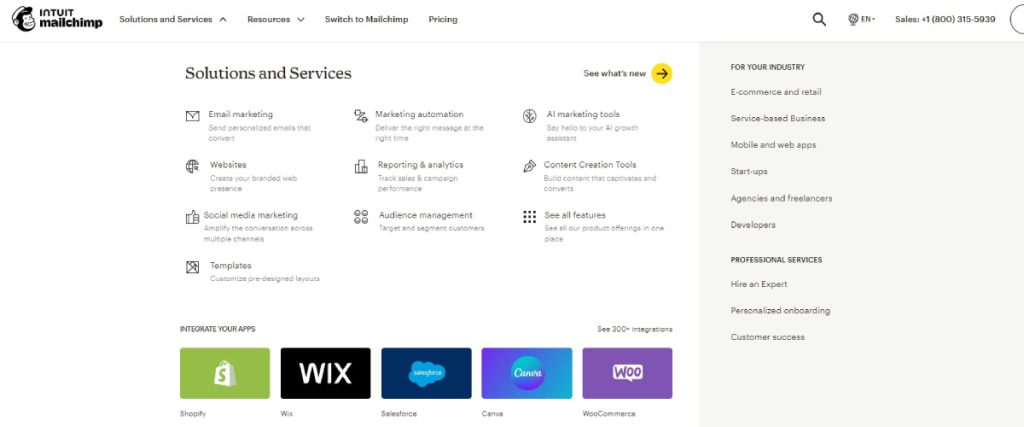
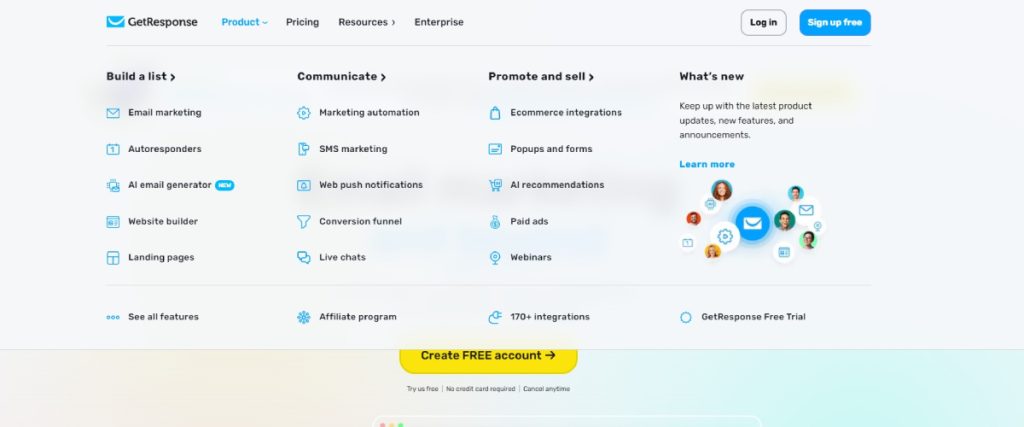
User Interface and Ease of Use
Mailchimp has long been celebrated for its user-friendly interface, making it a go-to choice for beginners. Its intuitive design allows users to quickly set up and launch campaigns without extensive technical knowledge. The platform offers over 100 customizable email templates, enabling users to create visually appealing emails with ease. As one user noted, “Mailchimp’s drag-and-drop editor made creating my first newsletter a breeze. I was up and running in no time.”
GetResponse, while slightly more complex, offers a customizable dashboard that caters to more experienced marketers. Its interface provides greater flexibility and advanced features, which can be a double-edged sword. The platform includes 200+ modern, mobile-responsive templates that are fully customizable, offering more design options for those willing to invest the time. An experienced marketer commented, “GetResponse’s customization options are fantastic, but there’s definitely a learning curve for newcomers.”
Automation Capabilities
In the realm of automation, GetResponse takes the lead with its advanced features. The platform offers a visual automation builder that allows users to create complex workflows based on user behavior. This level of sophistication is particularly beneficial for businesses looking to implement detailed, multi-step marketing strategies. GetResponse’s automation tools include features like Perfect Timing and Time Travel, which optimize email send times for better engagement.
Mailchimp, on the other hand, provides basic automation features suitable for simple marketing needs. While this may be sufficient for small businesses or those new to email marketing, it can be limiting for companies seeking more intricate automation sequences. Mailchimp’s automation includes built-in A/B testing tools for subject lines, content, and send times, supporting up to 3 variants, which is less than GetResponse’s 5 variant option.

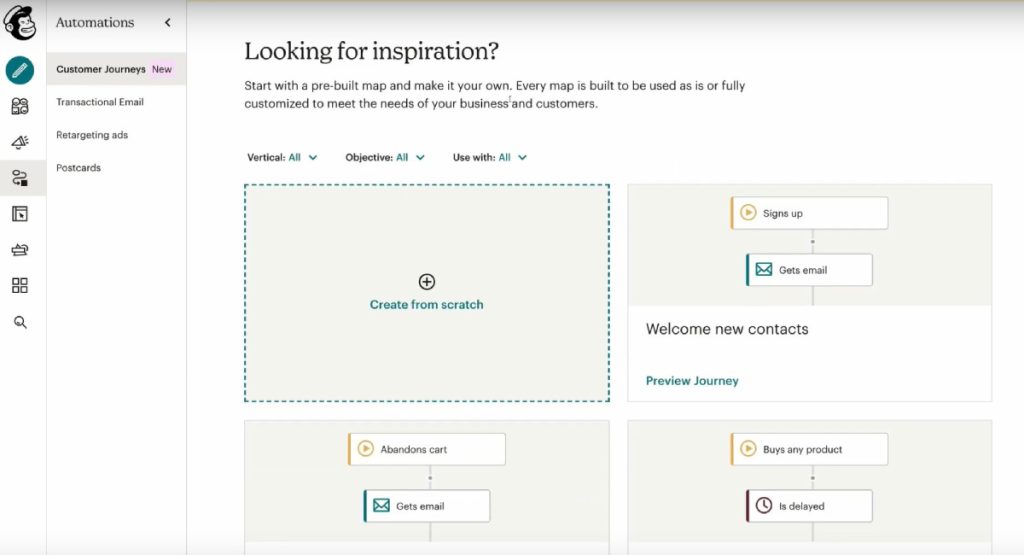
Pricing and Value
Pricing is a crucial factor for businesses of all sizes. Mailchimp’s pricing structure starts at $13/month for paid plans, but costs can increase significantly with additional features and larger contact lists. The platform uses a more restrictive method of calculating list size for billing, counting all contacts, including unsubscribed ones.
GetResponse generally offers more affordable options, with unlimited email sending on paid plans, providing better value for high-volume senders. Their list calculation method is more lenient, not counting unsubscribed contacts towards billing. This can result in significant savings for businesses with large mailing lists.
Dr. Emily Chen, a digital marketing expert, observes,
“While Mailchimp’s free plan is attractive for startups, GetResponse’s pricing structure often proves more cost-effective as businesses scale their email marketing efforts.”
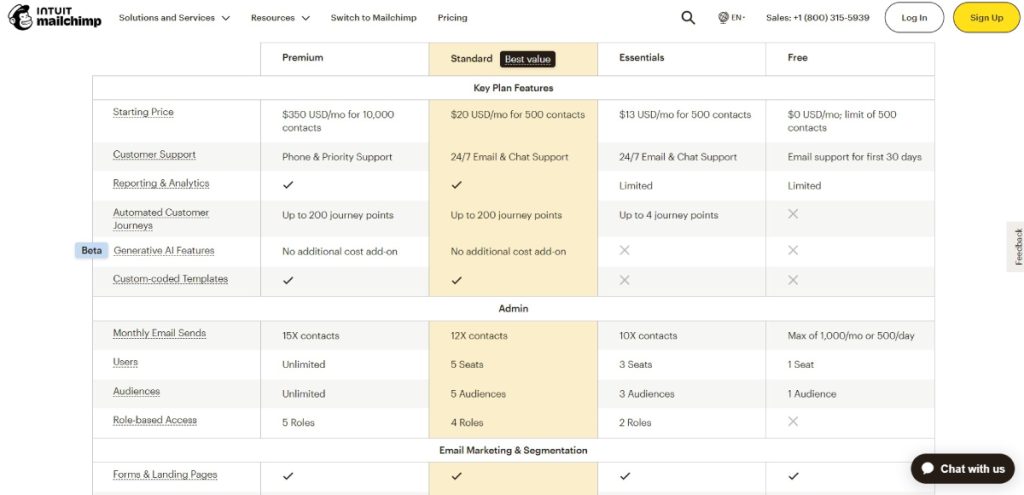
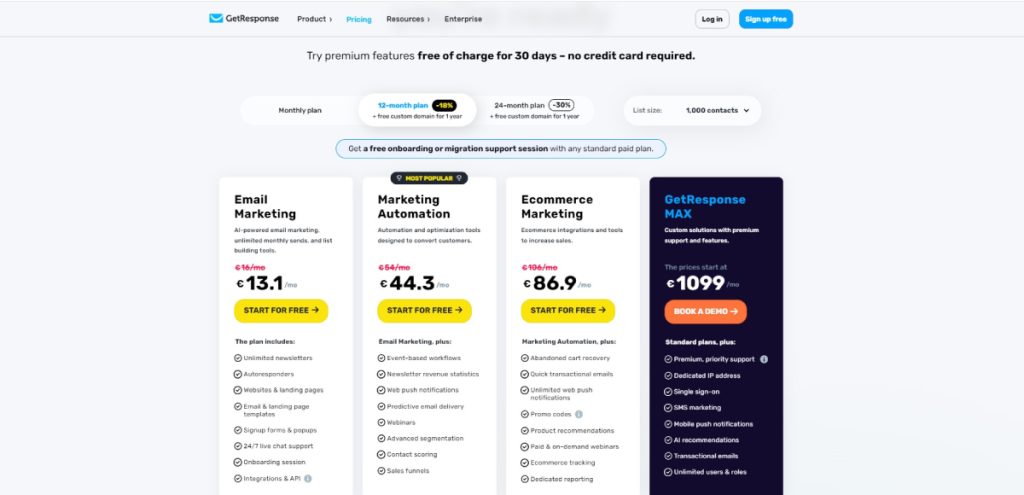
Integration and Additional Features
Mailchimp shines in its integration capabilities, supporting over 200 tools including major platforms like Salesforce and Shopify. This extensive integration network can be a significant advantage for businesses using multiple software solutions. Mailchimp also offers a mobile app for campaign management on the go and includes social CRM functionalities.
GetResponse, while offering fewer native integrations, compensates with unique features like integrated webinar hosting in its Pro plan. This can be a game-changer for businesses that rely heavily on webinars for lead generation and customer engagement. GetResponse also offers a calendar view for autoresponders, simplifying the management of drip campaigns, a feature not available in Mailchimp.
Both platforms have recently integrated AI tools to enhance content creation and optimize subject lines, showing their commitment to leveraging cutting-edge technology in email marketing.
Hidden Gems: 5 Lesser-Known but Highly Effective Features of GetResponse
Perfect Timing
Perfect Timing is one of GetResponse’s standout features designed to maximize email engagement. This intelligent scheduling tool analyzes your subscribers’ past interactions to determine the optimal time to send each email. By leveraging machine learning algorithms, Perfect Timing predicts when individual subscribers are most likely to open and interact with your emails.
Benefits:
- Increased Open Rates: Emails are sent at times when subscribers are most receptive, potentially boosting open rates by up to 40%.
- Enhanced Engagement: Timely emails lead to higher click-through rates as subscribers are more likely to engage with content when they are active.
- Personalized Communication: Sends emails based on individual behaviors, ensuring each subscriber receives communication tailored to their habits.
Use Case: For an eCommerce business, sending promotional emails during times when customers are most likely to shop can significantly increase sales conversions.
Dark Mode Preview
The Dark Mode Preview feature ensures that your emails look impeccable across different viewing modes, particularly in dark mode settings used by many email clients and devices. With the increasing popularity of dark mode for reducing eye strain and saving battery life, it’s essential that your email designs remain visually appealing regardless of the mode.
Benefits:
- Improved Aesthetics: Maintains the visual integrity of your emails, ensuring that images, text, and other elements display correctly.
- Enhanced Readability: Prevents issues like inverted colors or unreadable text that can occur in dark mode, ensuring your message is clearly communicated.
- Better User Experience: Provides a consistent and pleasant reading experience for subscribers who prefer dark mode, potentially increasing engagement.
Use Case: A content publisher can use Dark Mode Preview to ensure their newsletters are attractive and readable for subscribers who view emails during nighttime or prefer dark themes.
Loops in Customer Journeys
Loops in Customer Journeys allow marketers to create more intricate and personalized automation workflows within GetResponse’s Customer Journey Builder. Unlike Mailchimp’s linear automation sequences, GetResponse enables the creation of loops that can re-engage subscribers based on their actions or inactivity.
Benefits:
- Advanced Personalization: Tailors the customer journey based on real-time interactions, making each subscriber’s experience unique.
- Increased Flexibility: Allows for the creation of non-linear workflows, adapting to the subscriber’s behavior and preferences.
- Higher Retention Rates: Re-engages inactive subscribers or nurtures leads more effectively, reducing churn and increasing conversions.
Use Case: A SaaS company can create a looped journey that re-engages users who haven’t interacted with their product recently by sending targeted content and offers to bring them back.
Dynamic Segment Filters and Tags
Dynamic Segment Filters and Tags provide unparalleled precision in targeting your audience. This feature allows you to segment your subscriber list based on a multitude of criteria, including behavior, preferences, and engagement levels, ensuring that your communications are highly relevant to each group.
Benefits:
- Highly Targeted Campaigns: Sends tailored messages to specific segments, increasing the relevance and effectiveness of your campaigns.
- Improved Personalization: Utilizes detailed subscriber data to craft personalized content that resonates with each segment.
- Enhanced Analytics: Provides deeper insights into different segments, allowing for more informed decision-making and strategy adjustments.
Use Case: A travel agency can segment its audience based on past travel destinations and preferences, sending personalized offers and travel packages that match each subscriber’s interests.
Conversion Funnel Feature
Conversion Funnel Feature enables marketers to design comprehensive marketing campaigns that guide customers through the entire sales funnel, from initial awareness to final purchase. This feature integrates various touchpoints and channels, ensuring a seamless journey for the customer.
Benefits:
- End-to-End Campaign Management: Manages the entire customer journey within a single platform, simplifying campaign orchestration.
- Increased Conversion Rates: Guides customers through targeted steps, increasing the likelihood of conversion at each stage of the funnel.
- Comprehensive Tracking: Monitors customer interactions and behaviors throughout the funnel, providing valuable data for optimization.
Use Case: An online course provider can use the Conversion Funnel Feature to attract leads through content marketing, nurture them with educational emails, and convert them into paying students with targeted offers and follow-ups.
These hidden gems highlight GetResponse’s ability to offer advanced and nuanced features that can significantly enhance the effectiveness of your email marketing campaigns.
Innovative Solutions by Prism Reach
While Mailchimp and GetResponse offer robust email marketing solutions, the landscape of digital marketing is ever-evolving. Enter Prism Reach, an innovative AI-powered SaaS solution that’s redefining personalized newsletters for publishers, blogs, forums, and eCommerce businesses.
Prism Reach takes personalization to the next level, treating each subscriber as an individual rather than just a number in a list. By leveraging advanced AI technology, Prism Reach creates unique user avatars and journeys for each subscriber, enabling ultra-personalized content delivery that goes beyond traditional segmentation methods.
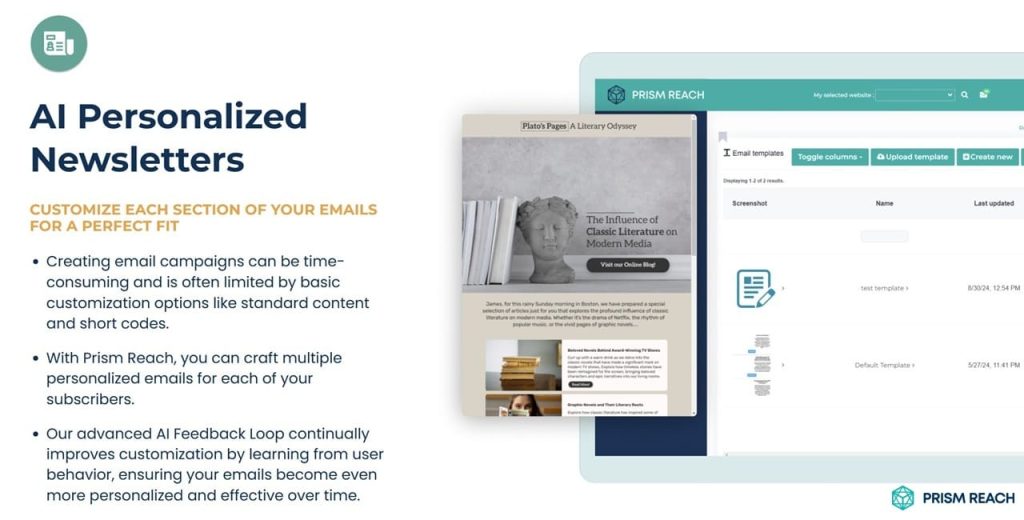
Key Benefits of Prism Reach
- AI-Powered Personalization: Transforms how publishers and content creators engage with their audiences by customizing every aspect of newsletters based on subscriber behavior and preferences.
- Increased Engagement: Publishers report up to 40% higher engagement rates due to the personalized nature of the content.
- Higher Revenue: Tailored advertising and efficient content targeting lead to higher monetization rates for published newsletters.
These benefits demonstrate how Prism Reach can complement or even surpass traditional email marketing platforms by providing deeper personalization and more effective engagement strategies.
Integration of Prism Reach with Existing Platforms
Prism Reach seamlessly integrates with both Mailchimp and GetResponse, allowing businesses to enhance their existing email marketing strategies without the need for a complete overhaul. This integration ensures that users can leverage the advanced personalization capabilities of Prism Reach while still benefiting from the robust features of their chosen email marketing platform.
Upgrade Your Email Marketing with AI Personalization!
As email marketing continues to evolve, the demand for more personalized and effective communication strategies grows. Prism Reach stands at the forefront of this evolution, offering a solution that not only meets but exceeds the capabilities of traditional platforms like Mailchimp and GetResponse.
By incorporating Prism Reach into your email marketing strategy, you can achieve unparalleled levels of personalization, engagement, and revenue growth. Whether you’re a small startup or a large enterprise, Prism Reach provides the tools and insights needed to take your email marketing to the next level.
Upgrade Your Email Marketing with AI Personalization!
FAQ
Conclusion
In the battle of Mailchimp vs GetResponse, there’s no one-size-fits-all answer. Mailchimp’s user-friendly interface and extensive integrations make it an excellent choice for beginners and businesses heavily reliant on third-party tools. GetResponse, with its advanced automation and more affordable pricing for larger lists, caters well to growing businesses and experienced marketers seeking sophisticated campaign capabilities.
However, as the email marketing landscape evolves, solutions like Prism Reach are pushing the boundaries of what’s possible in personalized communication. By harnessing the power of AI for hyper-personalization and automated optimization, Prism Reach offers a glimpse into the future of email marketing – one where each subscriber receives a truly unique and engaging experience.
Ultimately, the choice between these platforms depends on your specific business needs, technical expertise, and growth plans. As you evaluate your options, consider not just your current requirements but also how your email marketing needs may evolve in the future. Integrating tools like Prism Reach can provide a competitive edge, ensuring your email marketing strategies remain effective and relevant in a rapidly changing digital world.